
The permanent eggs of water fleas can remain in the sediment for several decades and then give rise to life again. The comet assay was adapted to detect damage to the genetic material. | Photo: Luc De Meester
For IGB researcher Dr. Dagmar Frisch, a long comet-like tail on an electrophoresis gel is not a good sign: The so-called comet assay indicates that the genetic material of the analysed cell has a high degree of damage. Compromised DNA moves across electric fields faster than intact DNA strands, leaving quantifiable signatures that resemble comet tails. Comet tail dimensions therefore reflect the relative DNA damage. Nevertheless, the scientist is happy with the result: it shows that the test works for this new application.
The comet assay is actually a test to analyse the toxicity of chemical substances on the genetic material of human cells. An international team led by IGB researcher Dr. Dagmar Frisch and Dr. Marcin Wojewodzic from the Norwegian Institute of Public Health has now adjusted this method to assess the genetic damage to the eggs of the microcrustacean Daphnia that increases with age or under environmental stress. The method also has the potential not only to check the quality of survival stages in archives and collections without costly DNA analyses, but also in natural aquatic bioarchives, e.g. in lake sediments. “The advantage of the test method is that we can apply it to individual life stages that have been exposed to environmental impacts in a natural setting," said Marcin Wojewodzic. Rejin Salimraj, the first author of the study adds: "It is also very cost-efficient and easy to implement”.
Dormant eggs: time capsules for climate impact research
In nature, various types of survival stages exist; seeds are familiar to everyone. Another example are the dormant eggs of Daphnia. These waterfleas reproduce mostly asexually by parthenogenesis: the offspring are genetic copies of the mother and therefore female. However, if the environmental conditions become inhospitable, males also develop. Sexual reproduction then results in long-lasting dormant eggs. Dagmar Frisch uses these to understand past ecological and evolutionary processes. “Permanent eggs are like time capsules. They can survive for centuries in the sediment of lakes. They help us in research, for example, to understand how organisms can adapt to different environmental conditions. This can provide us with important information, for example for climate impact research”, said the scientist.







